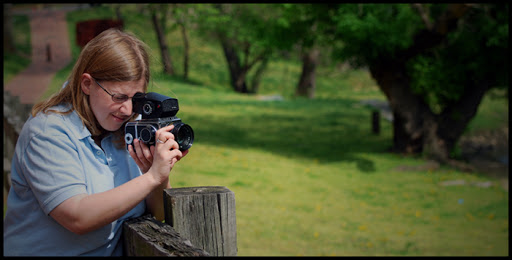Alexandra Silverthorne uses the camera as a means to understand and explore spatial environments and encounters. As projects evolve, her photographs often move beyond the mat and the frame to become sculptural objects, projections, and installations. Current projects include the examination of conceived, perceived, and lived space, instinctual explorations of architectural structures, and nocturnal documentation of unfamiliar landscapes.
Source: Alexandrasilverthorne.com
[Interview by Jordan Edwards of Gazette.net] By the time Alexandra Silverthorne graduated from Connecticut College in 2002, she had two passions: politics and photography. As an artist, she combines them to create pieces that play with the idea of environment and how politics affect space. Her work reflects time spent at Connecticut College and the Maine College of Art.
Photographs on display at BlackRock Center for the Arts in Germantown are more personal. The “A Building in Which” collage series includes images from five houses. Some are familiar to Silverthorne, others are not.
A few days after the opening of her show with Erin Antognoli and Beamie Young, the Washington, D.C., native talks about photographing the space around her, returning to film and life in New England.
Jordan Edwards: A lot of fine art photographers are turning away from digital photography and returning to film. Why have you decided to push forward with digital?
Alexandra Silverthorne: That’s a good question. I actually for many years was a film purist. I’ve been working in a darkroom since I was a freshman in high school. After college, I built my own darkroom. I teach all darkroom photography at UDC and AU. When I went to grad school, I knew I had to work quickly, and I knew I had to experiment and take risks that would be harder to take on a grad student budget. I got my first digital SLR right before I went to grad school, and I shot with that primarily all through grad school. But now, after school, I have a little bit more time to pace myself on my own projects. I have returned to film.
JE: You studied Political Science, Art and Philosophy as an undergraduate. Why didn’t you pursue photography right away?
AS: I entered college with plans to be an art history major. On a whim, I took a Political Science class, and I fell in love with it. I love the critical thinking. I love the challenges it presented. Even though I grew up in D.C., I really wasn’t fond of politics. Going away and being in Connecticut and discovering political science was really refreshing to me. I was always doing photography on the side.
JE: You’re really not a landscape photographer. You’re more interested in spaces and environments. How did you settle on that approach?
AS: It’s where my political science background and philosophy background come in. I think space and place is highly political. My earlier work was focused on politics in a very didactic derivative kind of way. But spacial investigations really challenge me to think about space and how we can see a space differently. Bringing something like spacial theory to something visual like a photograph can be really powerful and interesting. The interest has always been there, but it really became prominent in grad school.
JE: Can you explain the idea behind your “A Building in Which” project?
AS: The project started when I was in grad school. What I was interested in was the idea of a house. I had been staying with my aunt and uncle in Portland. It was a house I was familiar with because I had spent parts of my childhood there. I came across a quote by Maurice Merleau-Ponty. He talks about how you can’t simultaneously see everything in your apartment. You can see what’s in front of you with your eyes. Through your memory, you can visualize what’s behind you. I was in this house that I was partly trying to understand my own connection to. I thought about each room of a house and the idea of just being present in the space.
So I would spend 10 minutes by myself in each room of the house. For the first nine minutes, I would sit and look at things. Maybe look at something closer than I had before. For the last minute, I took 10 photographs of things I had seen during that time. Those are the 10 photographs that would go into each collage. I had rules. I had to photograph each room of the house except for the bathroom. Another rule was that I would only take 10 photographs. They’re not cropped. They’re full-frame.
JE: You’ve only been out of grad school for a year, so you’re not too far removed from Maine. How did the change in climate and scenery affect your photography?
AS: Actually, my grad school was a residency program. So I was in Maine during the summer, and then I was in Washington during the year. Each year I was working with a local advisor. I had summers in New England and a little bit in the winter, which was pretty much what my childhood was like. So it was pretty comfortable to me. Both my parents are from New England. It’s a place that feels very much like home to me. One of the reasons that I’m interested in space is the feeling that I do have two homes. The climate is different, though. Portland’s a really small town. It seems like in some ways that your days are much more packed because you’re constantly on the go. When I was up there during what they call the “Summer Intensive Program,” I tried to make it intense.

